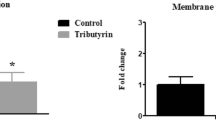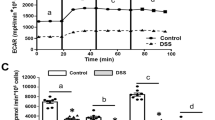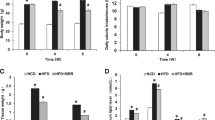Abstract
Inflammatory bowel disease (IBD) is often associated with a decrease in energy-dependent nutrient uptake across the jejunum that serves as the main site for absorption in the small intestine. This association has prompted us to investigate the bioenergetics underlying the alterations in jejunal absorption in 2,4,6-trinitrobenzenesulfonic acid-induced colitis in rats. We have found that mitochondrial oxygen consumption did not change in state 2 and state 3 respirations but showed an increase in state 4 respiration indicating a decrease in the respiratory control ratio of jejunal mitochondria during the peak of inflammation. This decrease in the coupling state was found to be guanosine diphosphate-sensitive, hence, implicating the involvement of uncoupling protein-2 (UCP2). Furthermore, the study has reported that the production of reactive oxygen species (ROS), known to be activators of UCP2, correlated negatively with UCP2 activity. Thus, we suggest that ROS production in the jejunum might be activating UCP2 which has an antioxidant activity, and that uncoupling of the mitochondria decreases the efficiency of energy production, leading to a decrease in energy-dependent nutrient absorption. Hence, this study is the first to account for an involvement of energy production and a role for UCP2 in the absorptive abnormalities of the small intestine in animal models of colitis.





Similar content being viewed by others
References
Oligschlaeger Y, Yadati T, Houben T, Condello Olivan CM, Shiri-Sverdlov R (2019) Inflammatory bowel disease: a stressed, "gut/feeling". Cells. https://doi.org/10.3390/cells8070659
Ordas I, Eckmann L, Talamini M, Baumgart DC, Sandborn WJ (2012) Ulcerative colitis. Lancet 380:1606–1619
Binder HJ, Ptak T (1970) Jejunal absorption of water and electrolytes in inflammatory bowel disease. J Lab Clin Med 76:915–924
Barada KA, Kafrouni MI, Khoury CI, Saade NE, Mourad FH, Szabo SS, Nassar CF (2001) Experimental colitis decreases rat jejunal amino acid absorption: role of capsaicin sensitive primary afferents. Life Sci 69:3121–3131
Mourad FH, Barada KA, Bou Matar D, Saade NE (2011) Jejunal glucose absorption is decreased in rat models of colitis through extrinsic neuronal mechanisms. J Crohns Colitis 5:S22
Santhanam S, Venkatraman A, Ramakrishna BS (2007) Impairment of mitochondrial acetoacetyl CoA thiolase activity in the colonic mucosa of patients with ulcerative colitis. Gut 56:1543–1549
Sifroni KG, Damiani CR, Stoffel C, Cardoso MR, Ferreira GK, Jeremias IC, Rezin GT, Scaini G, Schuck PF, Dal-Pizzol F, Streck EL (2010) Mitochondrial respiratory chain in the colonic mucosal of patients with ulcerative colitis. Mol Cell Biochem 342:111–115
Santhanam S, Rajamanickam S, Motamarry A, Ramakrishna BS, Amirtharaj JG, Ramachandran A, Pulimood A, Venkatraman A (2012) Mitochondrial electron transport chain complex dysfunction in the colonic mucosa in ulcerative colitis. Inflamm Bowel Dis 18:2158–2168
Liu DY, Pan CS, Liu YY, Wei XH, Zhou CM, Sun K, He K, Li C, Yan L, Fan JY, Wang CS, Hibi T, Liu HN, Han JY (2013) Huang Qi Jian Zhong pellet attenuates TNBS-induced colitis in rats via mechanisms involving improvement of energy metabolism. Evid Based Complement Alternat Med 2013:574629
Ahn BO, Ko KH, Oh TY, Cho H, Kim WB, Lee KJ, Cho SW, Hahm KB (2001) Efficacy of use of colonoscopy in dextran sulfate sodium induced ulcerative colitis in rats: the evaluation of the effects of antioxidant by colonoscopy. Int J Colorectal Dis 16:174–181
Reifen R, Nissenkorn A, Matas Z, Bujanover Y (2004) 5-ASA and lycopene decrease the oxidative stress and inflammation induced by iron in rats with colitis. J Gastroenterol 39:514–519
Lenaz G (2001) The mitochondrial production of reactive oxygen species: mechanisms and implications in human pathology. IUBMB Life 52:159–164
Naik E, Dixit VM (2011) Mitochondrial reactive oxygen species drive proinflammatory cytokine production. J Exp Med 208:417–420
Myant KB, Cammareri P, McGhee EJ, Ridgway RA, Huels DJ, Cordero JB, Schwitalla S, Kalna G, Ogg EL, Athineos D, Timpson P, Vidal M, Murray GI, Greten FR, Anderson KI, Sansom OJ (2013) ROS production and NF-kappaB activation triggered by RAC1 facilitate WNT-driven intestinal stem cell proliferation and colorectal cancer initiation. Cell Stem Cell 12:761–773
Galluzzi L, Kepp O, Kroemer G (2012) Mitochondria: master regulators of danger signalling. Nat Rev Mol Cell Biol 13:780–788
Weinberg SE, Sena LA, Chandel NS (2015) Mitochondria in the regulation of innate and adaptive immunity. Immunity 42:406–417
Osborn O, Olefsky JM (2012) The cellular and signaling networks linking the immune system and metabolism in disease. Nat Med 18:363–374
Colegio OR, Chu NQ, Szabo AL, Chu T, Rhebergen AM, Jairam V, Cyrus N, Brokowski CE, Eisenbarth SC, Phillips GM, Cline GW, Phillips AJ, Medzhitov R (2014) Functional polarization of tumour-associated macrophages by tumour-derived lactic acid. Nature 513:559–563
West AP, Khoury-Hanold W, Staron M, Tal MC, Pineda CM, Lang SM, Bestwick M, Duguay BA, Raimundo N, MacDuff DA, Kaech SM, Smiley JR, Means RE, Iwasaki A, Shadel GS (2015) Mitochondrial DNA stress primes the antiviral innate immune response. Nature 520:553–557
Esworthy RS, Aranda R, Martin MG, Doroshow JH, Binder SW, Chu FF (2001) Mice with combined disruption of Gpx1 and Gpx2 genes have colitis. Am J Physiol Gastrointest Liver Physiol 281:848
Echtay KS (2007) Mitochondrial uncoupling proteins—what is their physiological role? Free Radic Biol Med 43:1351–1371
Brand MD, Affourtit C, Esteves TC, Green K, Lambert AJ, Miwa S, Pakay JL, Parker N (2004) Mitochondrial superoxide: production, biological effects, and activation of uncoupling proteins. Free Radic Biol Med 37:755–767
Echtay KS, Brand MD (2007) 4-hydroxy-2-nonenal and uncoupling proteins: an approach for regulation of mitochondrial ROS production. Redox Rep 12:26–29
Yu X, Wieczorek S, Franke A, Yin H, Pierer M, Sina C, Karlsen TH, Boberg KM, Bergquist A, Kunz M, Witte T, Gross WL, Epplen JT, Alarcon-Riquelme ME, Schreiber S, Ibrahim SM (2009) Association of UCP2-866 G/A polymorphism with chronic inflammatory diseases. Genes Immun 10:601–605
Antoniou E, Margonis GA, Angelou A, Pikouli A, Argiri P, Karavokyros I, Papalois A, Pikoulis E (2016) The TNBS-induced colitis animal model: an overview. Ann Med Surg 11:9–15
Morris GP, Beck PL, Herridge MS, Depew WT, Szewczuk MR, Wallace JL (1989) Hapten-induced model of chronic inflammation and ulceration in the rat colon. Gastroenterology 96:795–803
Lawrence CB, Davies NT (1986) A novel, simple and rapid method for the isolation of mitochondria which exhibit respiratory control, from rat small intestinal mucosa. Biochim Biophys Acta 848:35–40
Gornall AG, Bardawill CJ, David MM (1949) Determination of serum proteins by means of the biuret reaction. J Biol Chem 177:751–766
Nagatake T, Fujita H, Minato N, Hamazaki Y (2014) Enteroendocrine cells are specifically marked by cell surface expression of claudin-4 in mouse small intestine. PLoS ONE 9:e90638
von Furstenberg RJ, Gulati AS, Baxi A, Doherty JM, Stappenbeck TS, Gracz AD, Magness ST, Henning SJ (2011) Sorting mouse jejunal epithelial cells with CD24 yields a population with characteristics of intestinal stem cells. Am J Physiol Gastrointest Liver Physiol 300:409
Amann M, Friedrich M, Lutterbuese P, Vieser E, Lorenczewski G, Petersen L, Brischwein K, Kufer P, Kischel R, Baeuerle PA, Schlereth B (2009) Therapeutic window of an EpCAM/CD3-specific BiTE antibody in mice is determined by a subpopulation of EpCAM-expressing lymphocytes that is absent in humans. Cancer Immunol Immunother 58:95–109
Goodyear AW, Kumar A, Dow S, Ryan EP (2014) Optimization of murine small intestine leukocyte isolation for global immune phenotype analysis. J Immunol Methods 405:97–108
Reuter BK, Asfaha S, Buret A, Sharkey KA, Wallace JL (1996) Exacerbation of inflammation-associated colonic injury in rat through inhibition of cyclooxygenase-2. J Clin Invest 98:2076–2085
Jekabsons MB, Echtay KS, Brand MD (2002) Nucleotide binding to human uncoupling protein-2 refolded from bacterial inclusion bodies. Biochem J 366:565–571
Echtay KS, Murphy MP, Smith RA, Talbot DA, Brand MD (2002) Superoxide activates mitochondrial uncoupling protein 2 from the matrix side. Studies using targeted antioxidants. J Biol Chem 277:47129–47135
Echtay KS, Roussel D, St-Pierre J, Jekabsons MB, Cadenas S, Stuart JA, Harper JA, Roebuck SJ, Morrison A, Pickering S, Clapham JC, Brand MD (2002) Superoxide activates mitochondrial uncoupling proteins. Nature 415:96–99
Zetzel L, Banks BM, SagalI E (1942) Intestinal absorption of an amino-acid mixture in patients with chronic idiopathic ulcerative colitis and entero-colitis. Am J Digest Dis 9:350–352
Mourad FH, Barada KA, Bou Rached NA, Khoury CI, Saade NE, Nassar CF (2006) Inhibitory effect of experimental colitis on fluid absorption in rat jejunum: role of the enteric nervous system, VIP, and nitric oxide. Am J Physiol Gastrointest Liver Physiol 290:262
Mourad FH, Barada KA, Saade NE (2017) Impairment of small intestinal function in ulcerative colitis: role of enteric innervation. J Crohns Colitis 11:369–377
Bar F, Bochmann W, Widok A, von Medem K, Pagel R, Hirose M, Yu X, Kalies K, Konig P, Bohm R, Herdegen T, Reinicke AT, Buning J, Lehnert H, Fellermann K, Ibrahim S, Sina C (2013) Mitochondrial gene polymorphisms that protect mice from colitis. Gastroenterology 145:1055–1063.e3
Roediger WE (1980) The colonic epithelium in ulcerative colitis: an energy-deficiency disease? Lancet 2:712–715
Kameyama J, Narui H, Inui M, Sato T (1984) Energy level in large intestinal mucosa in patients with ulcerative colitis. Tohoku J Exp Med 143:253–254
Dankowski T, Schroder T, Moller S, Yu X, Ellinghaus D, Bar F, Fellermann K, Lehnert H, Schreiber S, Franke A, Sina C, Ibrahim SM, Konig IR (2016) Male-specific association between MT-ND4 11719 A/G polymorphism and ulcerative colitis: a mitochondria-wide genetic association study. BMC Gastroenterol 16:118–121
Lewis K, Caldwell J, Phan V, Prescott D, Nazli A, Wang A, Soderholm JD, Perdue MH, Sherman PM, Mckay DM (2008) Decreased epithelial barrier function evoked by exposure to metabolic stress and nonpathogenic E. coli is enhanced by TNF-alpha. Am J Physiol Gastrointest Liver Physiol 294:669
Brand MD, Buckingham JA, Esteves TC, Green K, Lambert AJ, Miwa S, Murphy MP, Pakay JL, Talbot DA, Echtay KS (2004) Mitochondrial superoxide and aging: uncoupling-protein activity and superoxide production. Biochem Soc Symp 71:203–213
Guan L, Gong D, Tian N, Zou Y (2005) Uncoupling protein 2 involved in protection of glucagon-like peptide 2 in small intestine with ischemia-reperfusion injury in mice. Dig Dis Sci 50:554–560
Echtay KS, Esteves TC, Pakay JL, Jekabsons MB, Lambert AJ, Portero-Otin M, Pamplona R, Vidal-Puig AJ, Wang S, Roebuck SJ, Brand MD (2003) A signalling role for 4-hydroxy-2-nonenal in regulation of mitochondrial uncoupling. EMBO J 22:4103–4110
Teshima Y, Akao M, Jones SP, Marban E (2003) Uncoupling protein-2 overexpression inhibits mitochondrial death pathway in cardiomyocytes. Circ Res 93:192–200
Negre-Salvayre A, Hirtz C, Carrera G, Cazenave R, Troly M, Salvayre R, Penicaud L, Casteilla L (1997) A role for uncoupling protein-2 as a regulator of mitochondrial hydrogen peroxide generation. FASEB J 11:809–815
Lee SC, Robson-Doucette CA, Wheeler MB (2009) Uncoupling protein 2 regulates reactive oxygen species formation in islets and influences susceptibility to diabetogenic action of streptozotocin. J Endocrinol 203:33–43
Mailloux RJ, Harper ME (2011) Uncoupling proteins and the control of mitochondrial reactive oxygen species production. Free Radic Biol Med 51:1106–1115
Barada KA, Mourad FH, Sawah SI, Khoury C, Safieh-Garabedian B, Nassar CF, Saade NE (2006) Localized colonic inflammation increases cytokine levels in distant small intestinal segments in the rat. Life Sci 79:2032–2042
Hardin J, Kroeker K, Chung B, Gall DG (2000) Effect of proinflammatory interleukins on jejunal nutrient transport. Gut 47:184–191
Kreydiyyeh SI, Al-Sadi R (2002) The mechanism by which interleukin-1 beta reduces net fluid absorption from the rat colon. Eur Cytokine Netw 13:358–363
Wu CJ, Mannan P, Lu M, Udey MC (2013) Epithelial cell adhesion molecule (EpCAM) regulates claudin dynamics and tight junctions. J Biol Chem 288:12253–12268
Schnell U, Cirulli V, Giepmans BN (2013) EpCAM: structure and function in health and disease. Biochim Biophys Acta 1828:1989–2001
Trzpis M, McLaughlin PM, de Leij LM, Harmsen MC (2007) Epithelial cell adhesion molecule: more than a carcinoma marker and adhesion molecule. Am J Pathol 171:386–395
Kozan PA, McGeough MD, Pena CA, Mueller JL, Barrett KE, Marchelletta RR, Sivagnanam M (2015) Mutation of EpCAM leads to intestinal barrier and ion transport dysfunction. J Mol Med 93:535–545
Acknowledgements
We thank Samira Osman for technical assistance. This study was funded by the Faculty of Medicine and Medical Sciences, University of Balamand.
Author information
Authors and Affiliations
Contributions
MK, GMB, and KSE designed the study. YAO carried out the experiments. YAO, MK, SB, GMB, and KSE analyzed the data. YAO wrote the first draft of the manuscript and MK, SB, GMB, and KSE revised it. All authors have approved the final version of the manuscript.
Corresponding author
Ethics declarations
Conflict of interest
The authors declare no conflict of interest.
Additional information
Publisher's Note
Springer Nature remains neutral with regard to jurisdictional claims in published maps and institutional affiliations.
Electronic supplementary material
Below is the link to the electronic supplementary material.
Rights and permissions
About this article
Cite this article
Al Ojaimi, Y., Khachab, M., Bazzi, S. et al. Mitochondrial bioenergetics, uncoupling protein-2 activity, and reactive oxygen species production in the small intestine of a TNBS-induced colitis rat model. Mol Cell Biochem 470, 87–98 (2020). https://doi.org/10.1007/s11010-020-03749-z
Received:
Accepted:
Published:
Issue Date:
DOI: https://doi.org/10.1007/s11010-020-03749-z




